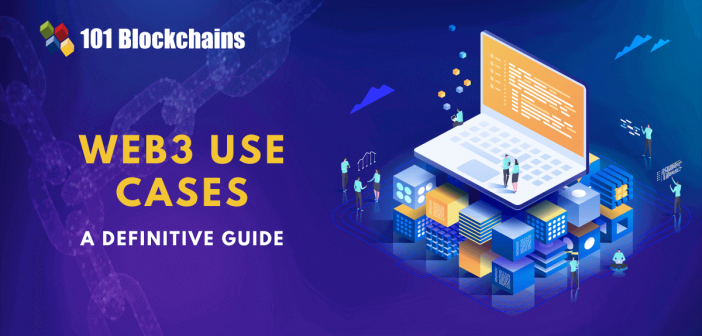Learn how blockchain truly works, master key definitions, and uncover what makes smart contracts so "smart." Dive into the fundamentals, gain valuable insights, and start your blockchain journey today!

Web3
James Howell
on March 23, 2022
Top Web3 Use Cases You Should Know
What is Web3 used for? What are top web3 use cases? Want to learn more about Web3 real-world applications? Read on to learn more!
The evolution of the internet over the years has been a staggering phenomenon, especially when you look at the milestones. In the earliest days of the internet, open protocols established the foundation for building the internet ecosystem. The first iteration of the internet, web 1.0, provided the grounds for developing some of the most prominent web assets and platforms. In the second era, known as web 2.0, closed protocols introduced centralization while outshining open protocols in terms of capabilities.
Now, the next phase of the internet, web 3.0, also referred to as the decentralized web, has become one of the prominent topics of discussion. The value of top web3 use cases is probably one of the foremost reasons for drawing attention to web3. The following post helps you discover the importance of web3 by reflecting on the different practical web3 use cases.
Definition of Web3
Before you try to find out “What is Web3 used for?” you should know what web3 is. In simple words, web3 or Web 3.0 is the third stage in the evolution of the internet. It provides decentralized networks for delivering faster user experiences with better personalization. The notable technologies underlying the development of web3 include artificial intelligence, semantic web, and machine learning. In addition, the blockchain web3 use cases also showcase the involvement of cryptographic security with web3 to facilitate security for user information. You can find the following unique traits on web3.
- Web3 is open, as it includes open-source software with the benefit of easy accessibility.
- Web3 networks are permissionless and users and providers don’t need permission from centralized controlling organizations.
- Another formidable trait evident in real-world web3 use cases is the freedom for users to interact privately and in public without any intermediaries in a trustless environment.
- Most important of all, web3 also offers ubiquity which can ensure the availability of the Internet irrespective of location, time, and device. For example, IoT technology can help in accessing internet services through many intelligent gadgets other than voice assistants.
Curious to develop an in-depth understanding of web3 application architecture? Join the Standard & Premium Plans and Enroll Now in Web3 Application Development Course!
Top Use Cases of Web3 That You Should Know
The characteristic traits of web3 prove its capabilities for transforming the internet experience for users. Is web3 just about revising UX elements in web applications and services? On the contrary, the best web3 use cases show a different story.
You can take a look through the following use cases of web3 to understand how the concept supports many applications.

Please include attribution to staging2.staging2.101blockchains.com with this graphic. <a href='https://staging2.staging2.101blockchains.com/blockchain-infographics/'> <img src='https://staging2.staging2.101blockchains.com/wp-content/uploads/2022/03/Top-Web3-Use-Cases-You-Should-Know.png' alt='Top Web3 Use Cases You Should Know='0' /> </a>
1. Decentralized Autonomous Organizations
One of the top entries among blockchain web3 use cases would point at Decentralized Autonomous Organizations or DAOs. They are basically online communities under the ownership of members of the community. The interesting highlight of DAOs is the facility of community governance which depends on the consensus of members. As a matter of fact, one can find out the highlights of web3 in DAOs with decentralization and autonomy.
A single individual or centralized entity cannot change the rules of DAOs. On top of it, DAOs ensure autonomy by using smart contracts for tallying votes and implementing decisions without the need for human intervention. If you look closely, DAOs are a prominent web3 example of on-chain governance. Decentralized Autonomous Organizations introduce the concept of corporate governance in the virtual world by encoding specific policies in smart contracts.
DAOs deserve a position among the top web3 use cases, especially for their potential in offering a governance model for web3 organizations. Interestingly, the principles of DAOs are applicable across a wide range of assets and organizations.
Build your fluency in Web3 and develop decentralized solutions with the world’s first Web3 Expert Career Path with quality resources tailored by industry experts Now!
2. Decentralized Finance
The next big answer to “What is web3 used for?” refers to decentralized finance or DeFi. It is a new concept based on the use of decentralized applications for financial services. Decentralized applications are basically general software applications associated with a series of smart contracts. The smart contracts in decentralized applications referred to as protocols, help in defining specific functionalities of the applications. The prominent advantage associated with decentralized apps in DeFi is that they will exist as long as the underlying blockchain exists.
Furthermore, dApps created on open blockchain networks allow the participation of any computer in the network. The real-world web3 use cases in DeFi have helped many people discover alternatives to traditional financial services. For example, DeFi has enabled the facility of crypto lending, and borrowing wherein crypto owners can receive loans against their crypto as collateral.
Another crucial highlight of web3 use cases in DeFi points at payment blockchains. DeFi has enabled payment blockchains that can facilitate peer-to-peer digital transactions. As a matter of fact, DeFi is one of the best web3 use cases, which shows a plausible improvement in cryptocurrency usage.
The significance of DeFi becomes clearly evident with the facility of low-cost, peer-to-peer, almost instantaneous, and borderless transactions. Payment blockchains in DeFi can serve as the best web3 example for enabling access to financial services. The payment blockchains could easily improve the existing payment systems. For example, cryptocurrencies can serve as a vital asset for the distribution of aid to people without bank accounts. In addition, DeFi also leverages blockchain for achieving the desired transparency to counter abuse, waste, and fraud.
The best thing about DeFi is that it is changing the backend of financial technologies. DeFi enables easier opportunities for using, accessing, auditing, upgrading, and developing financial services. DeFi is obviously one of the top web3 use cases focused on enabling cost-effective and easy participation in the financial system. At the same time, DeFi also leverages web3 principles for allowing complete control over ownership of finance products to consumers.
Want to learn and understand the scope and purpose of DeFi? Enroll Now in Introduction to DeFi- Decentralized Finance Course
-
The Defi and Web3 Connection
DeFi stands out as a top highlight among real-world web3 use cases as it presents prolific opportunities for improving financial inclusion. The DeFi and web3 connection depends on the fact that DeFi services embrace core values in the open internet. Here are the notable pointers which showcase how DeFi and web3 are related to each other.
- Dedication to open-source code
- Lower transaction fees
- Open accessibility
- Transparency and accountability in governance
- Permissionless
- Encryption-based privacy and security
Want to explore in-depth about DeFi protocol and its use cases? Join the Standard & Premium Plans and get free access to Decentralized Finance (Defi) Course- Intermediate Level Now!
3. Privacy and Digital Infrastructure
The most prominent issue in existing blockchain networks is complete transparency. You can find blockchain web3 use cases tailored for improving privacy and digital infrastructure. New research in the innovative facets of cryptography, such as zero-knowledge proofs, enables mathematical proofs of validity without disclosing information.
For example, a user can prove to a website that they know the password without giving the password to the website. As a result, the user’s password would never go on a database of the website, thereby ensuring safety from unprecedented attacks. Web3 solutions can ensure plausible improvements in digital infrastructure to provide the assurance of better privacy.
As one of the best web3 use cases, digital infrastructure improvements rely on the protection of users’ personal data. In addition, web3 has extended the flexibility for designing applications with improved privacy. Data protection is obviously one of the prominent highlights among many web3 use cases, considering the massive data breaches in Web 2.0. Now, web3 can provide the ideal foundation for accessing a suite of applications for improved protection of your data.
At the same time, the web3 use cases of privacy and digital infrastructure improvements could also improve regulatory compliance. Privacy layers can help users to overcome their apprehensions about sharing personal information with an application or service on blockchain. Therefore, web3 will obviously play a crucial role in easing the path to regulatory compliance in blockchain networks without risks.
Curious to learn about the value advantages of ZKPs for blockchain security? Join the Standard & Premium Plans and get free access to Zero Knowledge Proofs (ZKP) Masterclass Course
4. Blockchain Games
The most prominent web3 example in real use cases will draw you toward blockchain-based games. Developed on blockchain technology, the games offer their personalized economies where players have actual ownership over in-game items. Blockchain games are one of the notable answers to “What is web3 used for?” especially considering the fact that they were the earliest web3 applications.
Blockchain-based games offer the flexibility of transferring in-game objects to other games. In the initial stages, blockchain games have shown a promising glimpse into the future of gaming. With the support of web3 principles, blockchain-based games could open up completely new virtual worlds and economies.
The significance of blockchain games as one of the top web3 use cases is evident in the use of decentralized technology for facilitating monetization opportunities for creators. Blockchain-based games use NFTs for allocating ownership of in-game items such as avatars, skins, tools, experience points, and upgrades. Interestingly, players can sell the NFTs for fiat currency on secondary marketplaces alongside the privilege of transferring assets between games.
Another prominent highlight of blockchain-based games in real-world web3 use cases points at the play-to-earn models. One of the best examples of using web3 principles in the real world with gaming is Axie Infinity. It has served as a promising tool for many people to earn rewards in cryptocurrency by playing the game.
Learn the fundamentals, challenges and use cases of Web3.0 blockchain from the E-book: AN INTRODUCTION TO WEB 3.0 BLOCKCHAIN
5. Metaverse
Among the many entries in best web3 use cases, you would obviously come across the metaverse. The metaverse promises a boundless virtual world, a three-dimensional embodied internet, where users can move around as digital avatars. Basically, you will be on the internet rather than watching it through your computer screens.
The metaverse leverages many web3 principles for providing immersive and engaging experiences to users. You can find the element of decentralization and creator economies in the metaverse. The metaverse promotes open access to any individual and allows complete control of the experiences in the hands of users.
The recognition of metaverse as one of the top web3 use cases depends prominently on the promises of an open, shared, decentralized virtual world. However, the metaverse is still far from reality, and you can discover a few hints of the technology on different platforms. Facebook, Microsoft, Epic Games, and many other big names in the world of tech and business have identified the value of web3 principles in different metaverse applications.
6. Creator Economy
While you cannot term creator economy exactly as a use case of web3, it is one of the prominent highlights in the web3 landscape. The creator economy points to emerging creator communities, including developers, artists, and musicians, connecting directly with followers and supporters. Creators can rely on the principles of web3 for engaging in seamless collaboration without intermediaries.
One of the major highlights of creator economy in real-world web3 use cases refers to NFTs or non-fungible tokens. The new class of digital assets has soared to unreal levels of popularity, owing to the value of uniqueness. On top of it, high-profile NFT sales have also played a vital role in empowering creator economies.
The creator economy is one of the best web3 use cases because it allows monetization opportunities for people spending a major portion of their time online in various digital spaces. NFTs provide many new opportunities to creators for monetization while moving past the conventional gatekeepers. Therefore, the creator economy uses case of web3 can offer a favorable route for creators to sell their work directly.
In addition, followers can get exclusive ownership over the creator’s work, thereby increasing their stakes in the artists and creators. Another important highlight of NFTs in creator economy use cases points to the option of royalty payments. NFT owners can use smart contracts for tracking secondary sales and earning royalty commissions. Most important of all, NFTs serve as verifiable digital assets, thereby opening roads to many other applications beyond creator economies.
Final Words
The final overview regarding web3 based on the top web3 use cases shows how it can change internet experiences altogether. Starting from DAOs to the metaverse and DeFi, web3 has a lot in store for the whole world. While some of the web3 use cases have already started making an impact, some of them are still under development.
For example, DAOs and DeFi are the two examples of web3 use cases that are actively implemented now. On the other hand, you have the metaverse, which is still under development. The different use cases of web3 focus on the essential principles of web3 and how they can resolve conventional inefficiencies in data exchange, asset ownership, and financial transactions. Start learning more about web3 to discover its true potential right now.
*Disclaimer: The article should not be taken as, and is not intended to provide any investment advice. Claims made in this article do not constitute investment advice and should not be taken as such. 101 Blockchains shall not be responsible for any loss sustained by any person who relies on this article. Do your own research!








